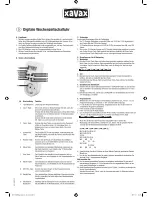
2
Photogate Timer
012-06379B
®
To Operate the Photogate Timer:
c
Plug the RJ12 phone connector from the timer into the
RJ12 phone jack on the Photogate Head.
d
Plug the 7.5 volt power adapter into the small recep-
tacle on the rear of the timer and into a standard 110
VAC, 60 Hz (or 220/240 VAC, 50 Hz) wall outlet.
e
Position the Photogate Head so the object to be timed
will pass through the arms of the photogate, blocking
the photogate beam. Loosen the clamp screw if you
want to change the angle or height of the photogate,
then tighten it securely.
f
If you are using a ME-9204B Accessory Photogate,
plug the stereo phone plug of the Accessory Photogate
into the large receptacle (see Figure 2) on the rear of
the timer.
g
Slide the mode switch to the desired timing mode:
Gate, Pulse, or Pendulum. Each of these modes is de-
scribed below. Switch the MEMORY switch to OFF.
h
Press the RESET button to reset the timer to zero.
i
As a test, block the photogate beam with your hand to
be sure that the timer starts counting when the beam is
interrupted and stops at the appropriate time.
j
Press the RESET button again. You are ready to
begin timing.
Timing Modes
Gate Mode:
In Gate mode, timing begins when the beam
is first blocked and continues until the beam is unblocked.
Use this mode to measure the velocity of an object as it
passes through the photogate. If an object of length L
blocks the photogate for a time t, the average velocity of
the object as it passed through the photogate was L/t.
Pulse Mode:
In Pulse mode, the timer measures the time
between successive interruptions of the photogate. Tim-
ing begins when the beam is first blocked and continues
until the beam is unblocked and then blocked again.
With an Accessory Photogate plugged into the Photogate
Timer, the timer will measure the time it takes for an
object to move between the two photogates.
Pendulum Mode:
In Pendulum mode, the timer meas-
ures the period of one complete oscillation. Timing be-
gins as the pendulum first cuts through the beam. The
timer ignores the next interruption, which corresponds to
the pendulum swinging back in the opposite direction.
Timing stops at the beginning of the third interruption, as
the pendulum completes one full oscillation.
Manual Stopwatch:
Use the START/STOP button in
either Gate or Pulse mode. In Gate mode the timer starts
when the START/STOP button is pressed. The timer
stops when the button is released. In Pulse mode, the
timer acts as a normal stopwatch. It starts timing when
the START/STOP button is first pressed and continues
until the button is pressed a second time.
TIMING DIAGRAMS
Operation
The following diagrams show the interval,
t,
that is
measured in each timing mode. In each diagram, a
low signal corresponds to the photogate being blocked
(or the START/STOP button pressed). A high signal
corresponds to the photogate being
unblocked (and the START/STOP button unpressed).
Photogate beam
7.5 volt
power adapter
to 120 VAC,
60 Hz
or
220/240 VAC,
50 Hz
Clamp screw: loosen to
adjust photogate angle or
height
MODE
DIAGRAM
GATE
PULSE
PENDULUM
Figure 2: Setting Up the Photogate Timer
Photogate Head
Plug in RJ12 connec-
tor from timer
t
t
t
t
t
t
t
t
t
t
t
Accessory
photogate port
Photogate port
7.5 volt
power port
Rear panel


































